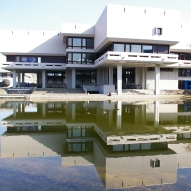Bodensteiner, Michael ; Dušek, Michal ; Kubicki, Marek M. ; Pronold, Michael ; Scheer, Manfred ; Wachter, Joachim ; Zabel, Manfred
Alternative Links zum Volltext:DOIVerlag
Zusammenfassung
The synthesis and spectroscopic characterization of [Cp*2Mo2P2Se3] (1; Cp* = C5Me5) and its use as a molecular building block in the formation of copper(I) halide polymers is described. The reaction of 1 in CH2Cl2 with 2 equiv. of CuBr and CuI in CH3CN under diffusion conditions gave [(Cp*2Mo2P2Se3)2(CuBr)2] (2) and [(Cp*2Mo2P2Se3)(CuX)3(CH3CN)]n (X = I; 3/4), respectively. The structure of 2 is ...
Zusammenfassung
The synthesis and spectroscopic characterization of [Cp*2Mo2P2Se3] (1; Cp* = C5Me5) and its use as a molecular building block in the formation of copper(I) halide polymers is described. The reaction of 1 in CH2Cl2 with 2 equiv. of CuBr and CuI in CH3CN under diffusion conditions gave [(Cp*2Mo2P2Se3)2(CuBr)2] (2) and [(Cp*2Mo2P2Se3)(CuX)3(CH3CN)]n (X = I; 3/4), respectively. The structure of 2 is distinguished by a central Cu2Br2 ring coordinated on each side by a tripledecker complex through one of its P atoms. A 2D network is formed by weak interactions between Se atoms of neighboring molecules. Compound [(Cp*2Mo2P2Se3)(CuI)3(CH3CN)]n exists in two isomeric forms 3 and 4. The crystal structure of 3 can be described as a two-dimensional polymer that is formed by ribbons containing looped chains of three Cu2I2 rings and attached [Cp*2Mo2P2Se3] molecules. The structure of 4 contains a ribbon in which tripledecker molecules are linked through their P atoms to (CuI)6 clusters. The ribbons are connected by weak Se···Se interactions. The reaction of a mixture of 1 and P4Se3 with CuI gave [(Cp*2Mo2P2Se3)(P4Se3)(CuI)2]n. The crystal structure analysis of 5 reveals a new type of organometallic–inorganic framework in which 1 and P4Se3 are linked by Cu2I2 rings.




 Altmetric
Altmetric